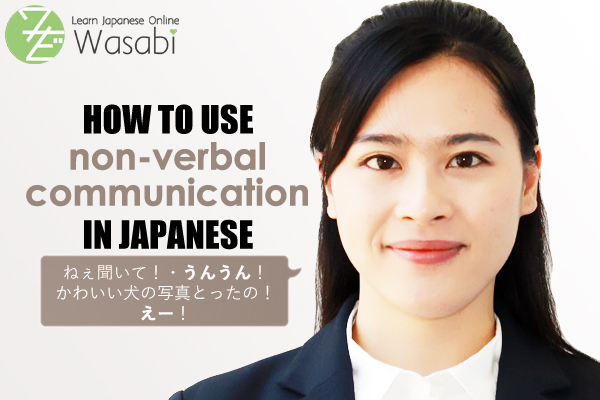How to Communicate Non-Verbally in Japanese
Welcome back to our “Video & Article” series with tutor Miki. In this article and video, Wasabi Japanese tutor Miki teaches you non-verbal/sound-based communication in Japanese, including some references to “あいづち” (sounds given during a conversation to communicate active listening) as well as body language. Learn more about communicating naturally and effectively in Japanese!
| Table of Contents [Introduction] [あいづち] [Eye contact] [Clapping your hands together to say sorry] |
[Introduction]
It is scientifically proven that only a fraction of what is communicated is actually done so via spoken words. More than 90% of any information and emotion conveyed is done so nonverbally. Of course, how this nonverbal communication takes place differs from culture to culture, and Japanese has many very culturally specific aspects in their communication that are important to bear in mind when studying and using the language.
In today’s lesson, Miki shares her stance on nonverbal communication in Japanese and how to adjust to it.
[adsense]
[あいづち]
First of all, you may have noticed that Japanese people nod a lot and say “はい” or “うん” a lot during conversations. There is even an old joke about a business negotiation between a Western and a Japanese company, during which the Japanese translator keeps on saying “Yes” to everything, only for the deal to be rejected by the Japanese side in the end.
The point of this anecdote is that the Japanese words for “Yes” don’t always mean approval, but often communicate the listeners active participation during the conversation.
This way of listening is called “あいづち”. Take a look at this sample conversation:
A: ねぇきいて
A: Hey, listen!
B: うんうん
B: Yeah!
A: この前かわいい犬がいたから写真をとったの!
A: The other day, I saw a cute dog, so I took a picture of it!
B: えー!
B: Whaaat!
A: みてみて。
A: Look at this.
B: わー!
B: Wow!
This example may be a bit exaggerated, but this is an example of the Japanese way of constant active listening. Of course it’s not exclusive to the Japanese language, but more pronounced than for example in English.
To someone who isn’t used to this type of constant active listening, these interjections may seem like someone is constantly interrupting you. But please don’t take it that way. It’s simply the Japanese way of showing you that they are actively listening to you and engaged in your story.
You can learn more about Aizuchi here
[Eye contact]
Another aspect of Japanese nonverbal communication is eye contact. Compared to other cultures (especially Western cultures), Japanese people tend to make a lot less eye contact. Miki described how it took her some time to get used to making more eye contact when she stayed in the US. For some reason, Japanese people take it as a form of aggression and it can create an uncomfortable awkward air in the room if you make eye contact with someone constantly and for too long.
Of course, this does not refer to the romantic way of staring into each other’s eyes, but more in a general sense. Especially in business situations, Japanese people do not make frequent eye contact.
Miki describes how after living outside of the US, she has managed to make more eye contact when talking with people from Western cultures, and less when talking with Japanese people to ensure smooth communication.
Her advice is to adjust the rate of eye contact to the person you are talking to. If you notice less eye contact than you initiate from a Japanese business partner, friend, or significant other, it might be because of their culture, which has nothing to do with their interest in you or a potential business deal.
[Clapping your hands together to say sorry]
The third example we will look at today is the Japanese gesture for apologising. Japanese people place their palms together in front of their chest, as if for prayer, to communicate that the are sorry and to ask for forgiveness. For example:
A: 遅いよ!どこにいたの?
A: You’re late! Where were you?
B: ごめん!(Prayer hands) 乗るつもりだった電車を逃した。
B: Sorry! (Prayer hands) I missed the train I was supposed to take.
Men also often use it like this:
ごめん、すまん
Sorry
(Please watch the video to see the gestures).
That’s everything for today. Thank you for reading this article, and please feel free to consult our native Japanese language teachers if you have any further questions!
| 当たり前 | Natural, obvious |
| 感情 | Emotions |
| 本心 | True feelings |
| 情報 | Information |
| 意思疎通 | Mutual understanding |
| 研究 | Study, research |
| 発表 | Announcement, publication |
| 電車を逃す | To miss one’s train |
| 世界共通 | Common around the world |
| 非言語コミュニケーション | Nonverbal communication |
| 個人的 | Personally |
| 相槌 | Sounds given during conversation to signal comprehension |

How to use the particles “は”, “にとって”, & “には” in Japanese

Learn about お笑い (Owarai, Comedy) in Japanese


